Symposium “The Challenge of Nature Positivity: Whose Problem is Biodiversity Loss, and How can it be Solved?” Held by the Center for Biodiversity Science
2025.04.03 |
A symposium was held in collaboration with industry, government, academia, and finance in the Kyoto-Shiga area.
On March 14, 2025 (Friday), the Center for Biodiversity Science, Ryukoku University held a symposium in Room 101 East Hall of the Omiya Campus, titled “The Challenge of Nature Positivity: Whose Problem is Biodiversity Loss, and How can it be Solved?,” a collaborative symposium between industry, government, academia, and finance.
The symposium began with a presentation from Professor Hiroki Yamanaka (Faculty of Advanced Science and Technology, Ryukoku University), Director of the Center for Biodiversity Science. In the first part, a variety of guests presented reports on their research and initiatives related to biodiversity, and in the second part, a discussion was held with the presenters, as well as university research members and guests from the financial industry. The meeting brought together knowledge from a variety of viewpoints on what can be done to build a social system for biodiversity conservation. The moderator for the event was Professor Atsushi Maruyama (Faculty of Advanced Science and Technology, Ryukoku University), a concurrent post researcher at the Center.
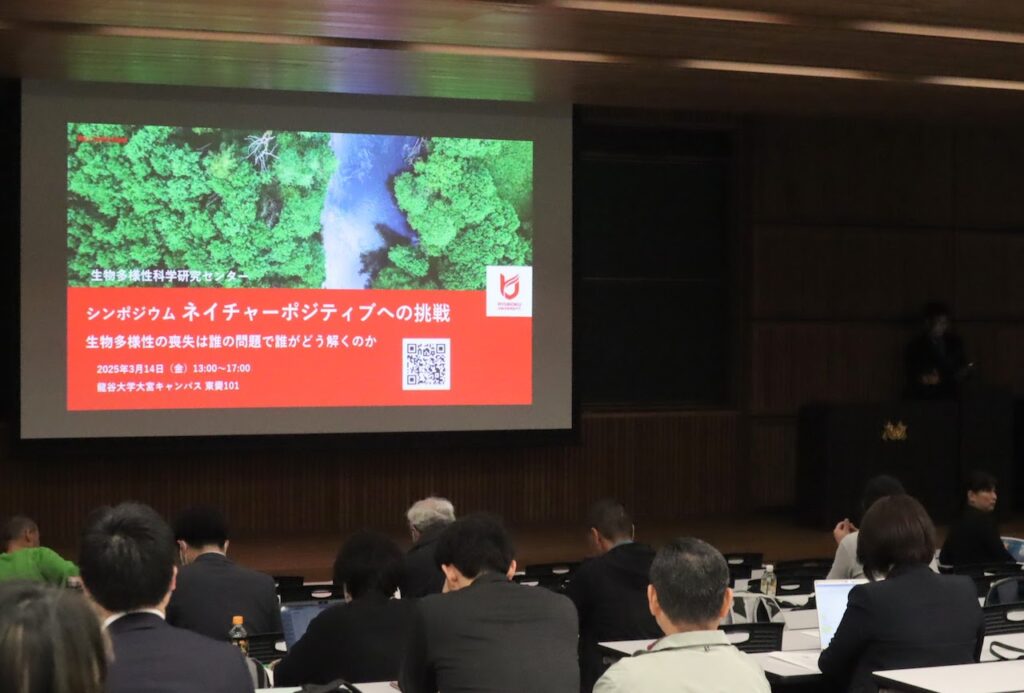

In his opening remarks, Masataka Fukao, Vice President of Ryukoku University referred to the Ryukoku Strategic Plan 400 for the 400th anniversary of the founding of the university in 2039, and said, “Nature positivity and biodiversity conservation are key themes for the university. I hope that there will be lively discussions so that environmental conservation can become the standard in society.” With these words, the symposium began.
First Part: Reports on Studies and Initiatives
The first presenter was Professor Yamanaka. Professor Yamanaka reported on the analysis results of the Lake Biwa Challenge: 100 sites eDNA survey performed in 2024, which has been performed since 2021 with the cooperation of local companies, NPOs, and others. He said, “The results indicate that the number of native species is increasing,” and added that the data collected is currently being prepared for dissemination.
He pointed out, “The difficulty with nature positivity is that it has a strong regional aspect, unlike carbon neutrality.” He emphasized, “Corporate participation is essential for the initiative to engage with socio-economic systems and expand.” He then introduced the establishment of a Biodiversity Stakeholders Conference as a forum for discussing the creation of mechanisms for corporate participation and the creation of data indicators to promote this. “The Center for Biodiversity Science aims to contribute to solving these problems by providing environmental technology focused on environmental DNA analysis, and by building problem-solving collaborative organizations,” he said, stating his objective.
The second speaker was Tadashi Masuzawa (Senior Manager for Biodiversity Promotion, Regional Environmental Planning Inc., Vice President, The Geoecological Conservation Network).
Masuzawa presented materials related to the Kunming-Montreal Global Biodiversity Framework(*1) and the World Economic Forum, and said, “We have entered an era in which nature-positive management creates business opportunities.” Next, he touched on the National Biodiversity Strategy of Japan, and shared important points required of the business sector, such as ESG investment, promotion of TNFD to local companies, and 30by30(*2).
Taking into account the international situation, Masuzawa pointed out, “No indicators are showing the value and degree of contribution to biodiversity, so this is raising the hurdle for companies.” He said, “I hope that local governments will provide data to serve as the basis for capital investment.” Also, from the viewpoint of a construction consultant who deals with the natural environment, he expressed his expectations for the Biodiversity Stakeholders Conference, saying, “An organization that smoothly connects companies, local governments, and activity groups is needed in order to establish local governance focused on nature-friendly sites.”
Notes:
*1 Kunming-Montreal Global Biodiversity Framework: New global targets for biodiversity adopted in 2022.
https://www.biodic.go.jp/biodiversity/about/treaty/gbf/kmgbf.html
*2 30by30: An international environmental conservation target that aims to effectively conserve more than 30 % of land and ocean as healthy ecosystems by 2030. In Japan, a new national biodiversity strategy, the National Biodiversity Strategy of Japan 2023-2030, was approved by the Cabinet in March 2023, and the 30by30 target has been adopted as one of the targets for achieving nature positivity by 2030.
https://policies.env.go.jp/nature/biodiversity/30by30alliance/
The third speaker was Michiko Yamaguchi (Executive Director and Secretary General, Higashiomi Sanpoyoshi Foundation).
First, she introduced the Higashiomi Sanpoyoshi Foundation, which is primarily funded by donations from local residents. The Foundation has a track record of business support and establishing institutional loans in collaboration with local Shinkin banks (credit unions).
Next, she referred to the Akane Fund for Connecting People with the Forests of Higashiomi, which has developed a number of collaborative projects across sectors, and the SIB project in collaboration with the Japanese Ministry of the Environment, which has worked to improve the river environment. In particular, she said that the SIB project did not necessarily receive a good response from local small and medium-sized enterprises, and remarked, “I felt that there were issues in motivating local companies to think about biodiversity.”
Yamaguchi also said, “There are many situations where solving social issues is difficult using existing financial systems,” and noted that the foundation is currently considering setting up a new impact fund(*3). She expressed her aspirations, saying, “I want to make the most of the region’s natural resources, and contribute to realizing the well-being of the residents.”
Note: *3 Impact fund: A fund that is managed with an emphasis on realizing impacts (effects) on various social issues, and not just on financial returns.
The fourth speaker was Junko Miyoshi (Environmental Quality Group, Sustainability Promotion Department, Daifuku Co., Ltd.).
Miyoshi introduced the environmental initiatives of Daifuku Co., Ltd., a company that provides material handling systems. The company adopted a company-wide environmental policy in 2011, and in 2014 launched a biodiversity conservation project at its Shiga Works. The company aims to realize a world in which its products have zero environmental impact by 2050.
Miyoshi introduced the various biodiversity conservation activities being carried out at the Shiga Works, showing on the screen conservation activities for rare species such as the Yamato salamander and dragonflies, external exchanges, and symposiums held to raise employee awareness, etc. She stated firmly, “Our goal is to reduce our negative impact on natural capital down to zero.”
The fifth speaker was Hiroki Okumura (Planning and Environmental Learning Section, Environmental Policy Division, Lake Biwa Environmental Department, Shiga Prefecture).
In a report titled “Nature Positivity x Regional Vitalization: Creating Communities that Live in Harmony with Nature,” the issues and outlooks were discussed from the viewpoint of the government.
While introducing the initiatives and policies of the Shiga Biodiversity Strategy 2024, Okumura stated, “Shiga Prefecture is rich in nature and its residents have a high level of environmental awareness, and it is important not only to increase conservation initiatives but also to improve their quality.”
On the subject of the Mother Lake Goals (MLGs), Lake Biwa’s version of the SDGs, he reported that a subcommittee held on the theme of “nature-positive management” had attracted people from a wide range of professions. He said, “Nature positivity is becoming a keyword that brings together people from different standpoints.”
He stressed the necessity for accurate information handling and human resource development, and the importance of intermediary support as keys to promoting biodiversity conservation. For the future, he said, “I would like to see efforts made to increase initiatives that make use of the characteristics of each region.”
The sixth and final speaker in Part 1 was Shunsuke Imada (Curator, Lake Biwa Museum, Shiga Prefecture).
Regarding the theme of biodiversity, Imada made a presentation on “The Past and Future of Museums that Pass on Materials to the Future,” in which he expressed his thoughts on what museums should be like. He said, “The plant and animal materials held by museums are useful as a basis for formulating national strategies.”
In his report, he emphasized, “Materials may be useful 100 years from now, but once lost they cannot be recovered. That is why it is so important to collect and store them appropriately.” He then gave several examples of how museum materials have been useful in research. Also, he said that there are always difficulties with collecting and preserving materials, and stressed that, in order to avoid the risk of materials being discarded, it is necessary for the organization to secure funding, of course, but also to continue to attract sustained attention. In conclusion, he said, “A more proactive and socially beneficial approach is required.” He noted that this includes collecting materials not solely based on their current value, promoting the use of digital data, and returning knowledge to society.
Second Part: Discussion
In the second part, the presenters from the first part were joined by guests and research members from the university for a discussion on two themes. There was lively discussion on the utilization of biodiversity data and the construction of social systems, during which the importance of collaboration among diverse stakeholders was confirmed.
In the first theme, “The value of biodiversity surveys and the establishment and maintenance of such systems,” Professor Yamanaka was moderator, and three presenters (Masuzawa, Imada, and Okumura) and Professor Naoyuki Kishimoto (Faculty of Advanced Science and Technology, Ryukoku University) took to the stage.
Professor Yamanaka asked for their opinions on how to involve a wide variety of stakeholders. In response, Masuzawa suggested, “It might be effective for local governments and research institutions to effectively circulate the environmental information held by companies having Nationally Certified Sustainably Managed Natural Sites.” Regarding document storage, Imada suggested, “Citizen participation events might be effective in spreading awareness of the value of the survey efforts and collected data.”
Based on the results of MLGs activities, Professor Kishimoto said, “I felt that visualizing the situation will lead to the next step. The key will be to ensure accountability through objective evaluation by a third party.”
In the second half, a member of the audience asked, “How should one approach cases where corporate motivation is not adequately supported by the government?” Okumura advised, “How about explaining that this can lead to regional revitalization and the resolution of local issues?” Masuzawa added, “If funding is a bottleneck for the government, it is important for them to understand that some initiatives can be started without spending money.”
Professor Yamanaka said, “I understand that certification from the government is of great significance to companies. When we scientists are engaged in determining indicators, it is necessary to consider not only accuracy but also the broadest possible consensus among those involved.”
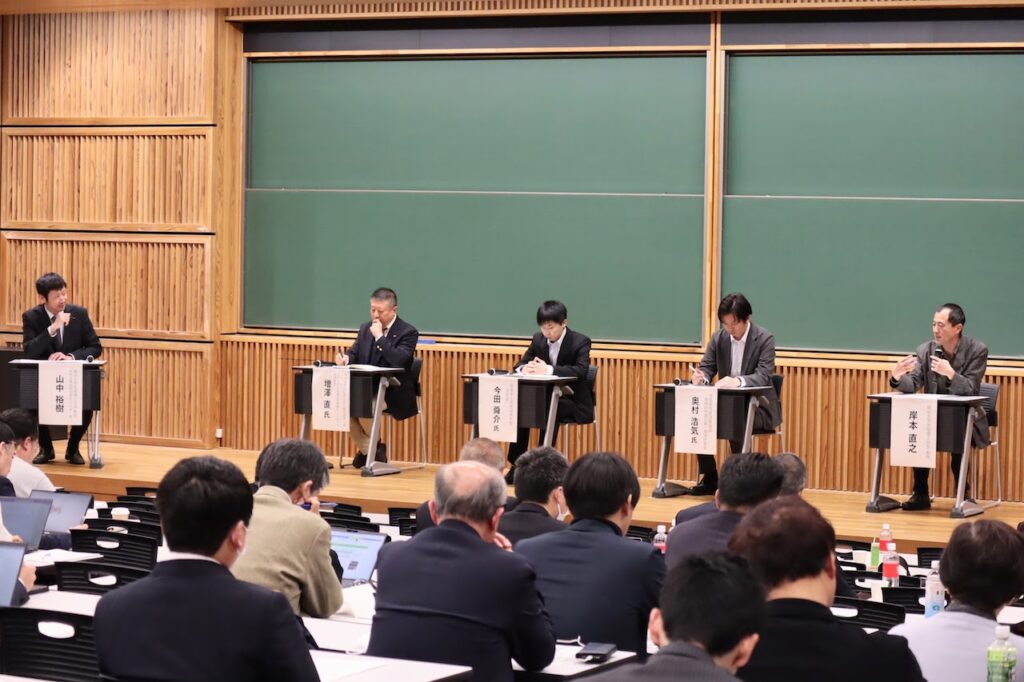
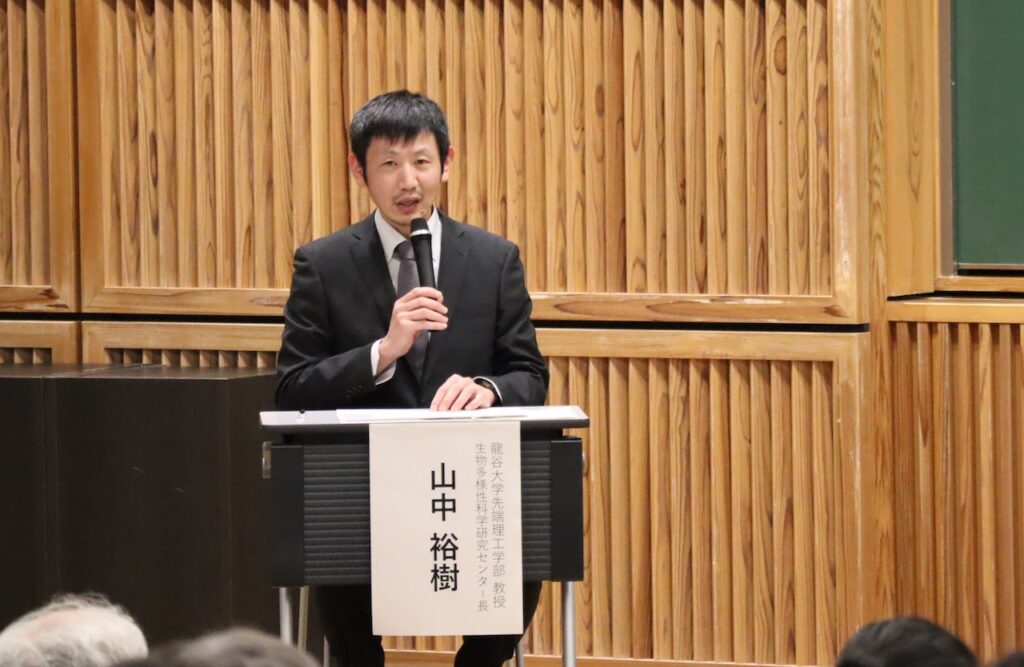
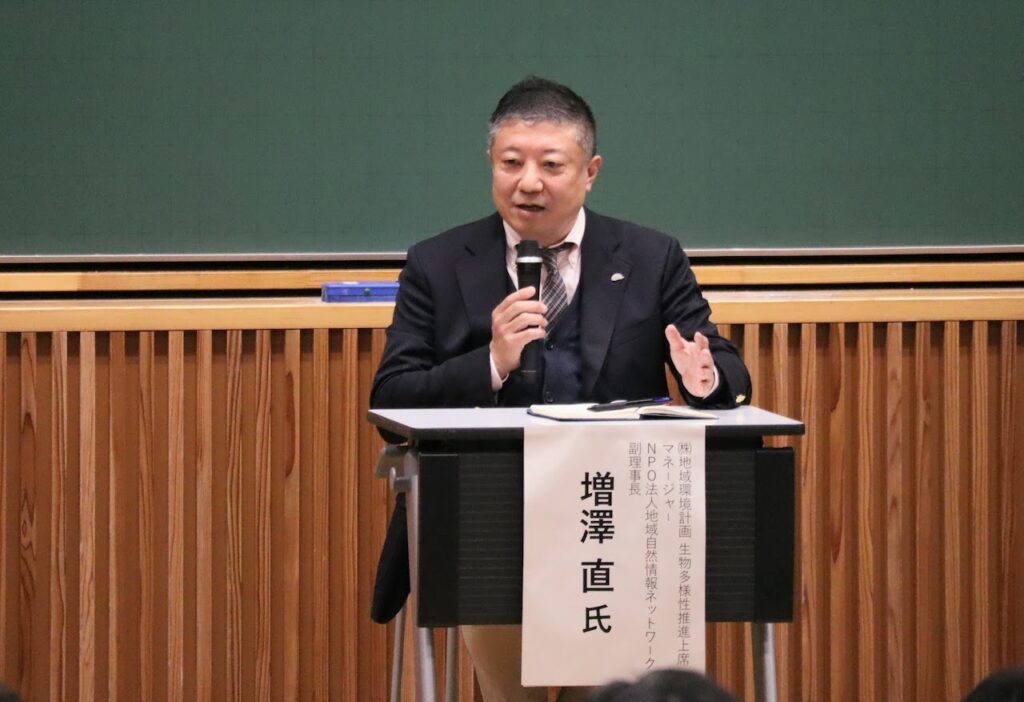

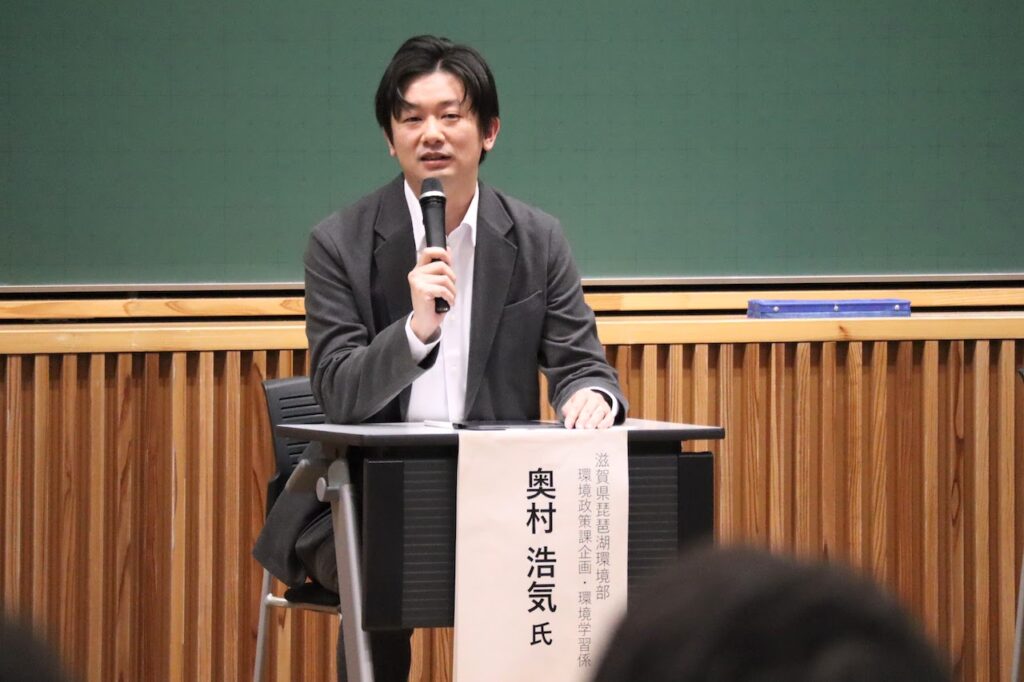
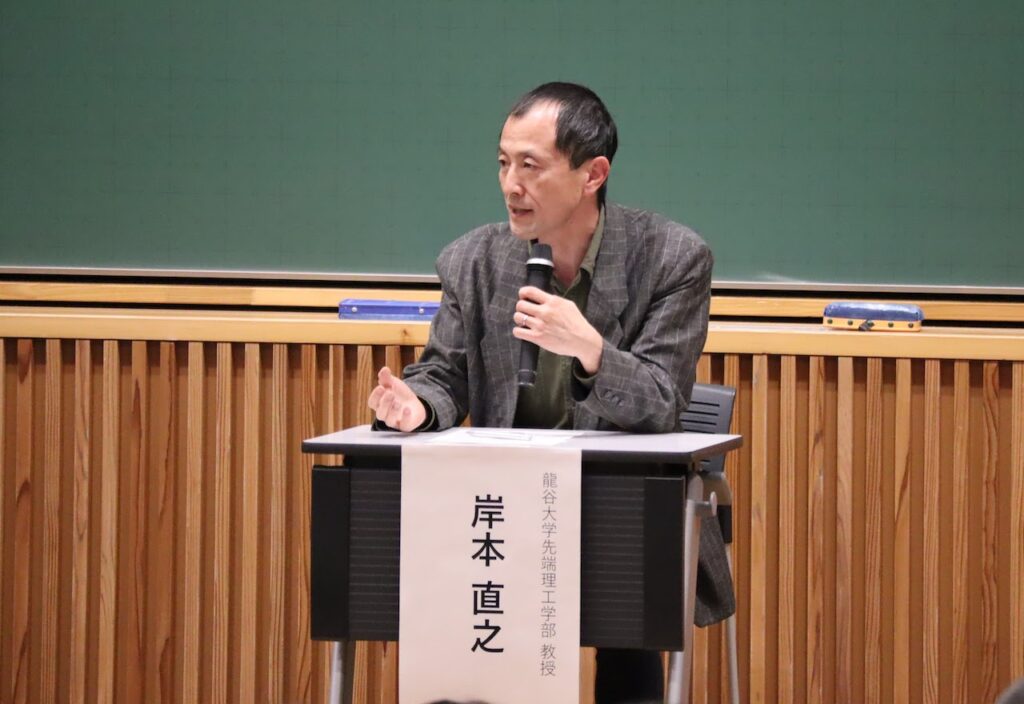
In the second theme, “Towards building a social system for conservation based on biodiversity data,” two presenters (Yamaguchi and Miyoshi) were joined on stage by guests Takuya Yamamoto (General Planning Department, The Shiga Bank, Ltd.) and Professor Keishi Tadatomo (Faculty of Policy Science, Ryukoku University). The moderator was Professor Fukao.
First, Professor Tadatamo raised the issue by saying, “For regional development, which should be cultivated over the long term, the judgment of economically rational people alone is not necessarily the correct one. The problem facing biodiversity conservation is the immaturity of we the citizens, who are unable to take the necessary action. Now is the time for a renewal of citizenship.”
Yamamoto replied, “Large companies now face disadvantages for not addressing issues such as decarbonization and biodiversity. On the other hand, small and medium-sized companies may not see the benefits of taking action amid rising prices and labor costs. As a financial institution, we feel the need to provide support that will lead to increased corporate value.” In response, Yamaguchi said, “There is a need to increase opportunities for people with diverse viewpoints to sit at the same table. This will cultivate a common language, resulting in greater awareness.” When asked about raising awareness within the company, Miyoshi introduced their unique initiative, saying, “It is certainly difficult to deepen understanding about biodiversity conservation, even within the company, because there are no clear indicators. However, by creating motivation through a points system for contributing to environmental and social activities, I feel that the number of colleagues participating is gradually increasing.”
After this lively exchange of opinions, Professor Fukao concluded by saying, “In building the Center’s Biodiversity Stakeholders Conference, it is important to go through repeated small trial and error cycles without being confined to the current framework.”
In aiming to build a new social system, opinions were exchanged from a variety of perspectives.
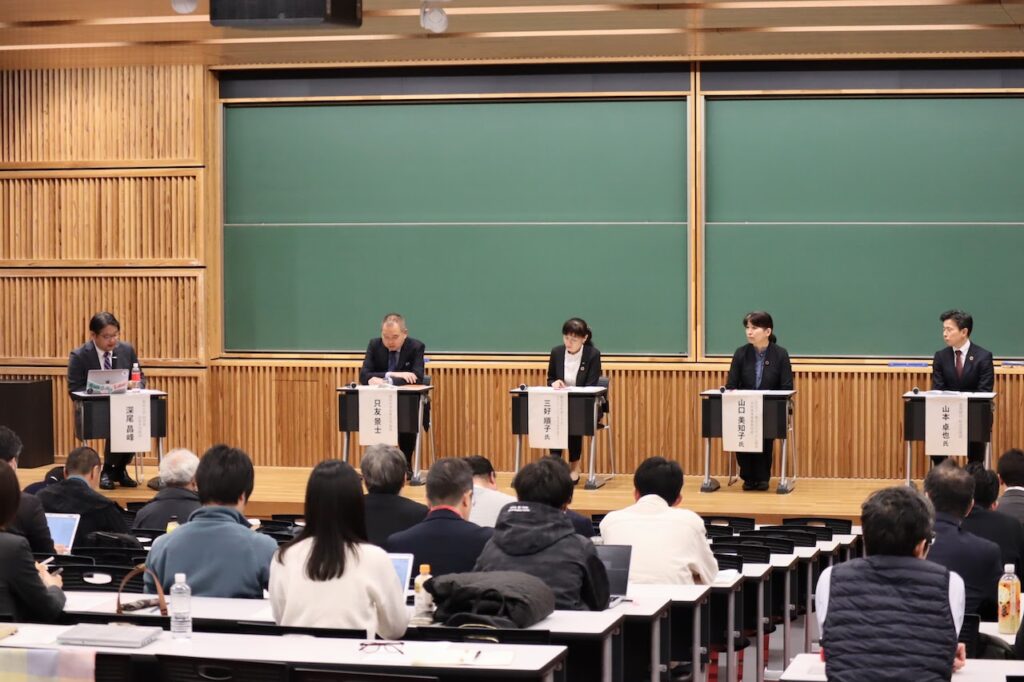

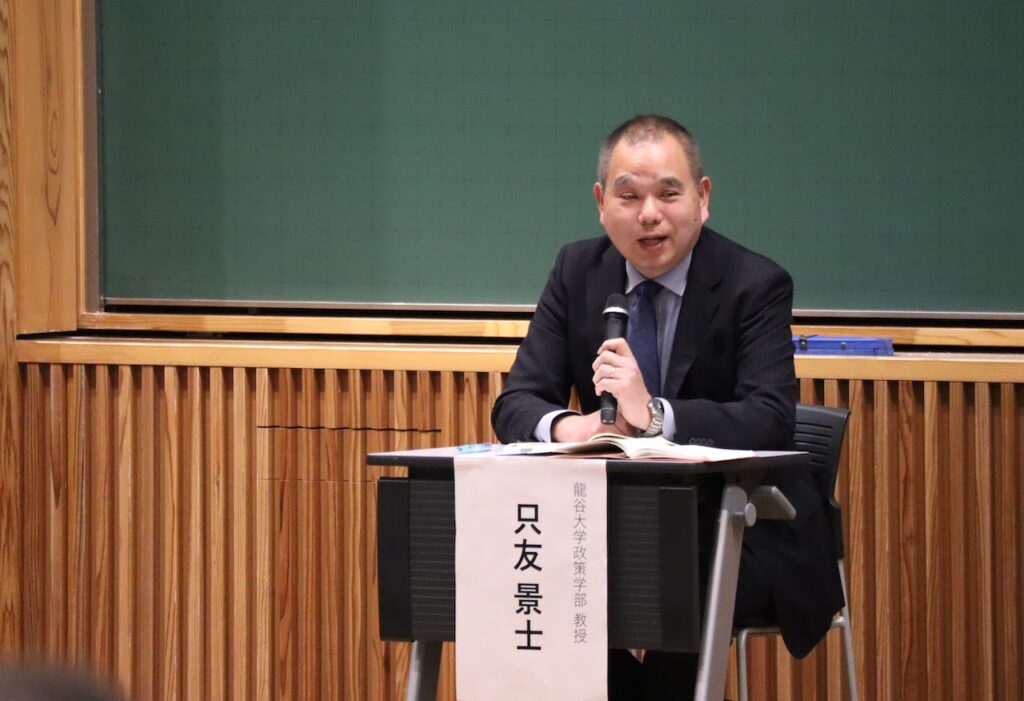
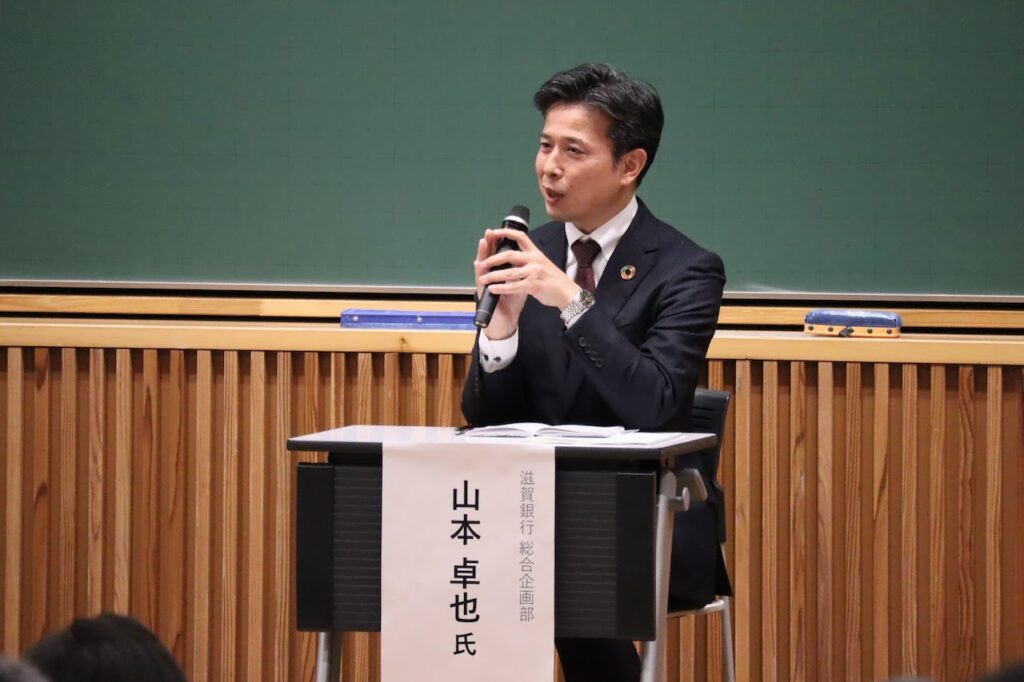
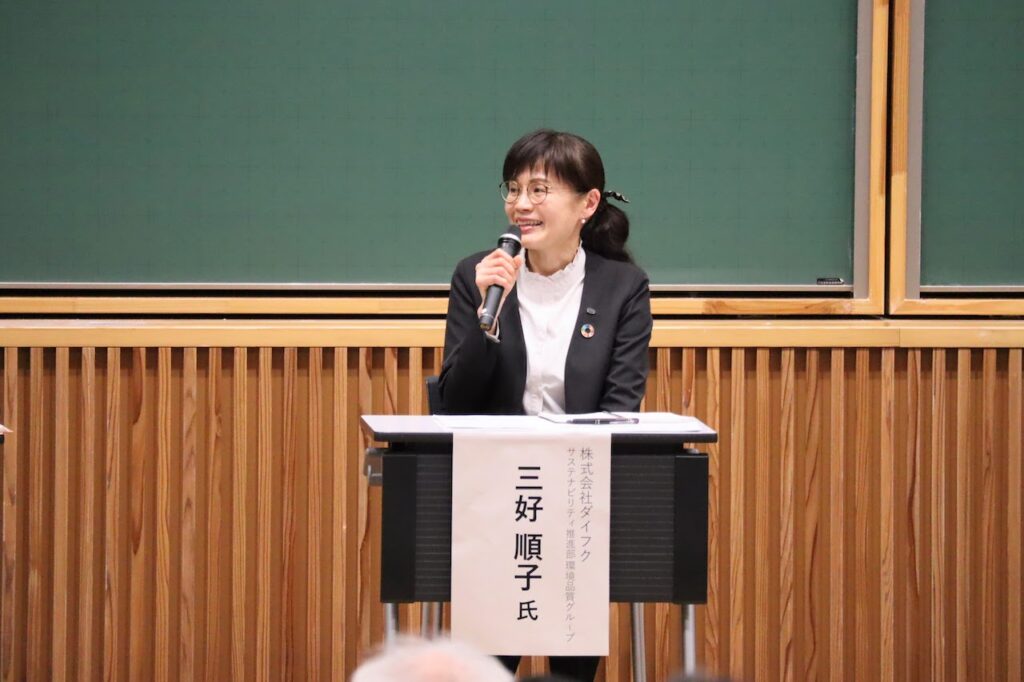
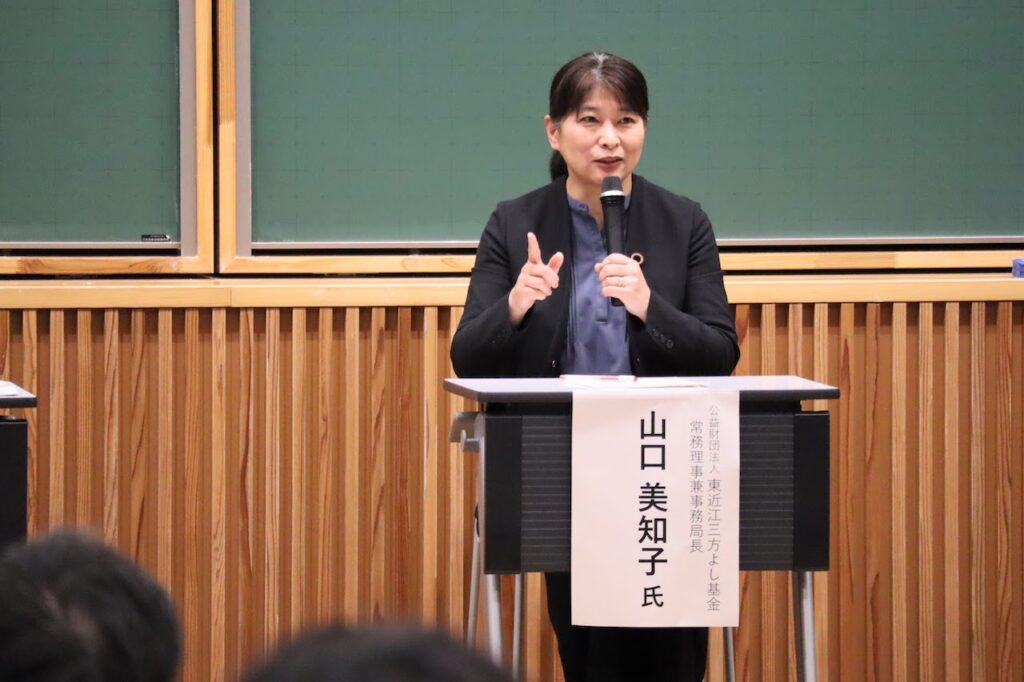
As the symposium reached its final stage, Yusuke Shimizu (Environmental Safety Office, Research Center, Toyobo Co., Ltd.), one of the symposium’s sponsors, came on stage and made a speech. He expressed his gratitude to the participants, and commented, “It was an event that allowed me to learn from the knowledge of each expert, and it stimulated my intellectual curiosity.”
Finally, Professor Yamanaka gave the closing remarks, emphasizing, “Being indifferent to biodiversity is the same as forcing inconvenience on someone, somewhere.” He stressed the need for the Biodiversity Stakeholders Conference as an opportunity to revitalize the region from a nature-positive perspective, and called on the many people in the hall to actively participate. Concluding the symposium, he expressed his gratitude to the participants.
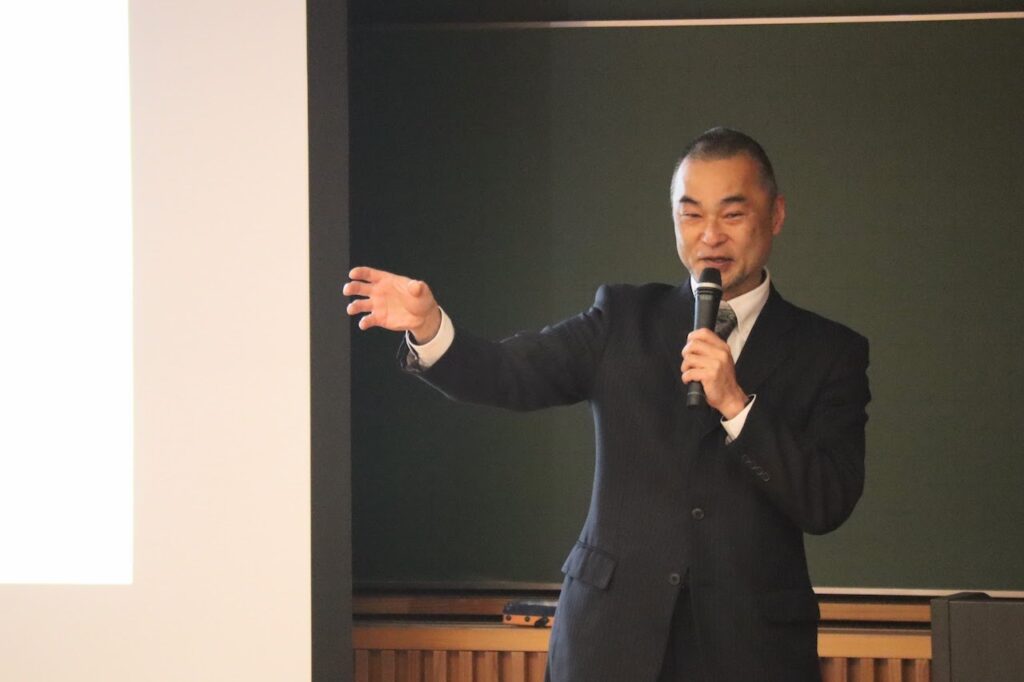
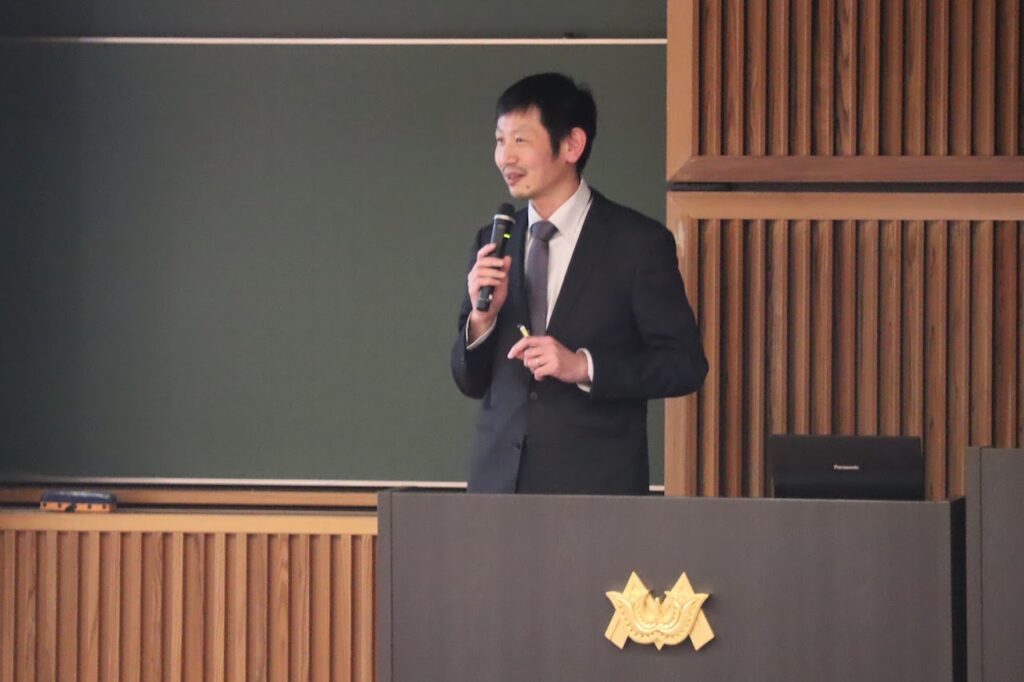
The Center for Biodiversity Science of Ryukoku University will continue to provide opportunities for the integration of knowledge from various perspectives across industry, government, and academia, in order to build a social system that realizes nature positivity.